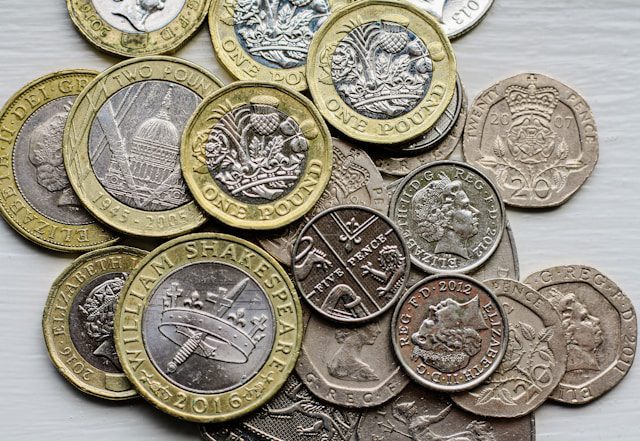Ever wondered why the prices of goods and services go up and down in the UK? As with many territories, it’s all to do with inflation – an economic phenomenon that can mean we end up paying more for everyday things (and even treats) at different times.
All kinds of things can affect and influence UK inflation. If you’ve spent any time paying attention to the British news over the past few years, you’ll know that a “cost of living crisis” has forced the UK into something of a bind as far as inflation is concerned. Various societal and financial shifts have been at play since 2020 – in particular, Brexit and the COVID-19 pandemic!
In this fact file, I’ll be taking a look at some facts about UK inflation to help inform your understanding and bring you up to speed with some of the more important statistics and news from the past few years. As someone who’s always keen to get the best value for money (who isn’t, honestly?), inflation is really important to me – and it’s a huge economic factor in the UK as much as it is in the US and Canada.
So, let’s start with the basics and branch out with some interesting facts about UK inflation!
1. UK inflation determines cost increases.
If you’ve ever wondered why the price of things changes over the years, that’s inflation. In the UK, economists and everyday people use inflation to track how much costs change over long periods. It’s known as a rate or level of inflation.
In fact, you can even measure inflation on as small a scale as daily or weekly – though many economists look at a much bigger picture, such as analyzing inflation changes pre- and post-pandemic.
2. We can measure British inflation from long, long ago.
Believe it or not, it’s actually possible to measure the price of things in the UK going back centuries! There are some calculators available online, for example, that tell us how much certain items and goods were back in the Middle Ages.
Many people use online inflation calculators for the British economy to track how much it might have cost to buy a car or a house back in the 1980s. Essentially, £5 back in 1984 is technically worth a lot more nowadays!
3. Inflation has risen significantly in the early 2020s.
The onset of the COVID-19 pandemic and the UK’s major decision to move out of the European Union, via what became known as Brexit, helped to make big changes to the country’s economic performance and stability. Some commentators (and various British citizens) also believe that former Prime Minister Liz Truss’s controversial economic policies helped to make the cost of living even more expensive.
Generally, the level of inflation in the UK has risen on a steady curve since 2000. Believe it or not, the country saw record low inflation rates over the past two decades.
However, that wasn’t to last. Inflation stood at around 2.1% in spring 2021, but increased to dramatic highs of 11.1% in fall 2022 – that’s shortly after Liz Truss took office and appointed her Kwasi Kwarteng as Chancellor of the Exchequer.

4. Inflation in the UK reached its peak in the 1970s.
For all the recent spikes in inflation in Britain have been fairly dramatic, the UK is still some way from its record peak.
Back in 1975, when Harold Wilson was UK Prime Minister, the country witnessed inflation rates as high as around 25%. That meant things were getting more expensive for British citizens in a very short space of time.
However, Britain’s economy bounced back – and it has done so, variously, over the years. That said, it’s never a wise idea to assume there will always be a financial plateau – you never truly know what’s around the corner!
5. At the time of writing, inflation is decreasing.
Thankfully for British citizens, the rate of inflation seems to be back on a consistent downward trend. From its 11.1% peak in late 2022, the economy has since recovered to around 2%, which is the Bank of England’s base point.
In fact, inflation rates have been as low as just above 0% at specific points over the past few years. For all COVID-19 changed things financially for millions of people at the time, inflation tended downward across 2020 until 2021.
Similarly, in 2015 leading into 2016, there’s a significantly consistent low inflation record. This seemed to spike around 2017 and hit levels above the Bank of England’s target of 2% heading into 2018.
6. Inflation is calculated by a specific department.
The rate of inflation is fairly complex to calculate, which means it’s a task best left to experts working in the Office for National Statistics, or the ONS.
The ONS works out inflation rates based on a series of averages. They regularly measure how much it costs British people to buy more than 700 specific different items and products. This is known as their “basket.”
The overall cost of this “basket” tells the ONS, and us, what the Consumer Price Index, or CPI, is for the UK. This is the main calculation the ONS makes to come up with a base comparison figure.
7. The ONS calculates inflation based on CPI changes.
Put simply, the ONS takes CPI figures from year to year to look at how much prices have changed. For example, if certain items in their hypothetical basket are worth £40 in 2023 and £40.80 in 2024, that’s a yearly increase of 2%.
That also gives us our inflation rate – meaning prices are generally expected to go up by this amount, based on the averaged basket products, year on year.
Naturally, the ONS also tracks the prices of basket items across the year, too, so it can easily record changes across the months.
8. The ONS’ inflation basket contains lots of different physical
products and hypothetical services.
It’s easy to assume with a word like “basket” that the ONS only ever measures physical grocery items or assets when it comes to measuring British inflation. However, the basket actually includes a number of intangible items and services, too.
With over 700 different assets checked and calculated in the yearly basket, the list of what’s included is pretty extensive! However, it’s said to include physical items such as food, drink, tobacco, alcohol, clothing, health supplies, footwear, household goods, and entertainment items.
However, the ONS does also track pricing changes in services and purchases such as bus and train travel, tuition fees, restaurant bills, telephone rates, and the cost of going out on the town!
These are all important factors to keep tracking via the basket because they are popular items and services the average British person makes use of from day to day.
Check out the ONS’ full list of basket items!
9. Inflation can rise for many different reasons.
As mentioned, some major socioeconomic factors can cause inflation to increase in general, however, there are often other individual factors that can cause prices to rise in the basket, too.
For example, global shortages in chip production boosted the average cost of buying new cars. Petrol and energy prices have also increased over the years, with some economists believing a change in supply chain, exacerbated by sanctions imposed on Russia due to its invasion of Ukraine, may be partially to blame.

10. The Bank of England tries to control inflation.
Inflation is, as you might imagine, pretty difficult to manage and control. After all, it’s a concept, a calculation made by the ONS – to really get inflation down in the UK, you’d need to try and reduce the cost of most items in their basket!
That said, while the Bank of England, or BoE, doesn’t calculate British inflation, it does try to control and influence it. For example, by reducing and increasing interest rates as the economy demands.
However, the BoE has no strict control or say over price increases with commodities such as petrol. Fuel costs are largely determined by socioeconomic shifts and demands overseas, meaning the BoE can simply react and mitigate.
11. The Bank of England must always warn the Chancellor of the Exchequer about major inflation changes.
The Chancellor of the Exchequer is largely responsible for presenting British budgets – meaning they’re effectively at the head of British finance, working with the likes of the Bank of England to help keep inflation under control.
In fact, believe it or not, the BoE is required to warn the Chancellor, in writing no less, if there’s a major change to inflation in the UK. This typically means the BoE’s governor needs to write a formal (and publicly open) letter to the Chancellor when inflation is shrinking below 1%, or when it’s growing beyond 3%.
Essentially, this warning helps to keep the government and the public abreast about what’s changing in the economy, and advises people what the bank intends to do to get things back on track.
12. Low inflation can be as bad as high inflation in some cases.
Low inflation in the UK typically means people don’t make as much interest, or money back, on the money they save. That said, a lower rate means that everyday goods and services are cheaper than usual, to balance things out.
Low inflation, however, can sometimes make it cheaper for people to borrow credit in the UK. Not only are interest rates lower (and therefore repayments on things such as credit cards and mortgages generally cheaper), the amount of money you do pay toward debt repayment goes more toward your actual debt, not the interest your lender’s making on top.
Ultimately, high inflation benefits people who save because they can build interest with their banks. That said, if inflation rates are high, savers aren’t necessarily going to see immediate benefits because the cost of goods and services is increasing.

13. The UK adjusts its pensions in line with inflation.
In the UK, citizens are entitled to what’s known as a state pension, a retirement fund that offers them a weekly payout without having to work. This pension’s typically based on the National Insurance they pay across a lifetime.
However, state pension rates need to move with inflation so they’re still giving older people enough to use on goods and services!
It’s the government who takes control of the pension rates based on the ONS’ inflation figures. They measure the UK’s CPI every year, usually every September, and increase pension rates based on the previous year’s inflation.
14. Pensions are protected against inflation, to an extent.
The UK employs what’s known as a “triple-lock” pension system, which means the government raises pension rates either based on a guaranteed rate of at least 2.5%, average earnings per person, or the rate of inflation offered via September’s CPI.
However, it raises rates by the largest of the three figures – not the smallest one!
Interestingly, the UK removed average earnings from the triple-lock system during the COVID-19 pandemic, and instead moved to a double-lock system. This ensured pensions increased based purely on the figures of the CPI or the 2.5% guarantee.
15. There are different types of inflation in the UK.
Read up on what British economists have to say about inflation, and you’ll find there are a few schools of thought on how it increases and what changes the prices we pay for various items and services.
For example, Robert Gordon stated that a “triangle” model brings together three different types of inflation. These are built-in (referring to people wanting to be paid more as prices increase, thus it’s a self-fulfiling prophecy), demand-pull (where demand leads to price increases – such as toilet rolls during the pandemic!), and cost-push, which refers to material costs increasing.

16. The UK used to use a different system for measuring cost.
I’ve talked about the ONS and how it and the government uses the CPI to work out inflation rates – but the country actually used to use a very different type of measurement, known as the Retail Price Index, or RPI. The RPI includes payments people make toward debt and council tax.
The RPI is a calculating measure that appears to overstate inflation rates in the UK – and many economists see it as inaccurate or outdated. Despite this, the government has reportedly continued to use the RPI to determine how much train fares should be from year to year.
Rising rail fares has been a point of contention for many British commuters – meaning RPI isn’t exactly popular with the masses, either! It’s not seen as accurate compared to international measurements, either.
17. While you can measure inflation from a long time ago, it’s not
necessarily accurate.
Remember I mentioned that you can dive deep into British history to measure inflation from centuries ago? As fascinating as that might be, it’s not always seen as an accurate exercise.
In fact, many experts believe measuring inflation accurately on a historic basis only really takes us back to post-World War II, in 1947. That’s because 1947 was the first year the UK adopted the RPI system, which, as mentioned, is still used to some extent today.
18. Hyperinflation is more worrisome than high inflation in general.
High inflation can seem scary, but what matters more is the speed at which products and services increase. Consider the people of Germany post World War I, who were faced with virtually useless money after reparation demands sent the country’s inflation skyrocketing at short notice.
Again, the incredible inflation rate increase that occurred in late 2022 is a good example of hyperinflation – a huge boost to prices that occurred in an extremely short period of time. Hyperinflation sees the cost of everyday items escalate overnight – meaning everyday people often don’t have a chance to adjust in time.

19. Stagflation occurs when prices rise, but wages don’t.
It’s entirely possible for British prices to increase while wages stay the same – effectively, people can afford less with the money they have, and their salaries aren’t increasing to meet these new rates.
Stagflation can be difficult for British bodies to control and mitigate – raising interest doesn’t always help, as it can lead to companies going bankrupt and unemployment increases. Complex stuff!
FAQs About Inflation in the UK
Are food prices going down in the UK?
At the time of writing, food prices in the UK appear to be decreasing somewhat in line with inflation dropping. However, many people still have to use food banks as general grocery prices fluctuate.
Is the UK in high inflation?
As of the time of publication, the UK is experiencing an inflation rate within the Bank of England’s targeted remit. It experienced high inflation from October 2022 to early 2024.
Will the cost of living still be high in the UK?
Despite the UK’s inflation rate decreasing, many items and services in the UK will remain expensive – there is no guarantee how long the cost of living crisis will continue for.
Further reading
https://www.ons.gov.uk/economy/inflationandpriceindices
https://www.bankofengland.co.uk/monetary-policy/inflation
Do you know any interesting facts about UK inflation? Share them in the comments below!









